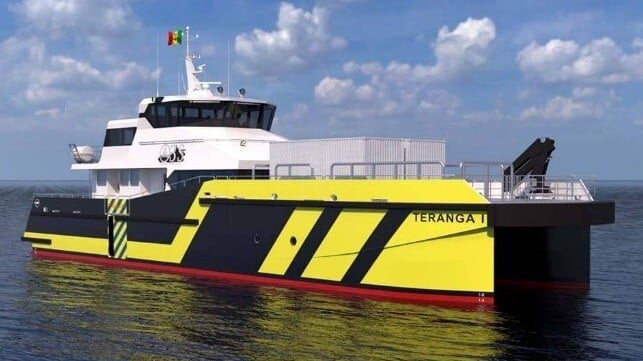FSV Blends Designs for Senegal's Emerging Offshore Energy Sector

Incat Crowther and Penguin International are working together to design and construct a new fast supply vessel (FSV) that represents a unique blend of features from the offshore wind and offshore oil and gas sectors. The vessel is also being built for the fledgling offshore energy sector emerging in West Africa.
The vessel was ordered by O3S (Oil Senegal Support Services), a homegrown Senegalese operator servicing the country's emerging offshore energy industry. The company is unique in that it is a 100 percent Senegalese entity dedicated to offshore maritime operations. Launched just three years ago, O3S reports it has already accumulated a fleet consisting of nine vessels including two Fast Support Intervention Vessel, two Surfer Vessels, two Cleaning Vessels, an Ambulance Vessel, and two Platform Supply Vessels. O3S reports it is placing orders to triple its fleet with a goal of developing a fleet of 25 to 30 Senegalese-flagged vessels.
The new vessel will be a 118-foot (36-meter) fast supply vessel capable of transporting 28 service personnel as well as 20 tonnes of cargo at speeds of up to 33.5 knots. The catamaran hull form is derived from Penguin's WindFlex-32 Crew Transfer Vessel (CTV), which was co-developed with Incat Crowther.
Designed with operational efficiency, the new vessel will be fitted with the latest emissions reduction technology to ensure it is IMO Tier III compliant as well as other features to improve its operations. The vessel will have an elevated wheelhouse to provide an excellent line of sight for the captain.
The large foredeck optimizes operational flexibility with a dedicated, enclosed cargo area and a FROG crew transfer crane that enables the safe transfer of personnel from the vessel to offshore infrastructure. The vessel will also be fitted with an ultra-high performance bow fender to optimize safety when transferring personnel to the platform in open ocean conditions.

that matters most
Get the latest maritime news delivered to your inbox daily.
Among the features for the crew and personnel being transported, the vessel will have an air-conditioned cabin on the main deck with seating as well as a medical suite. The main cabin will also contain a refreshment kiosk and large TVs for safety briefings. The upper deck will feature a spacious, dedicated mess area for service personnel and the vessel’s four crew. Each demi hull features two berths for the vessel’s crew.
Construction on the new FSV is expected to start later this year, with delivery of the vessel expected to take place in 2025.
